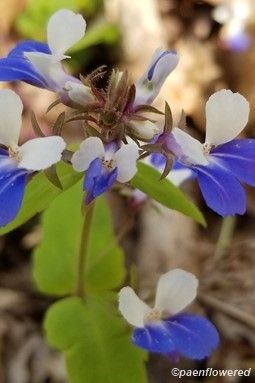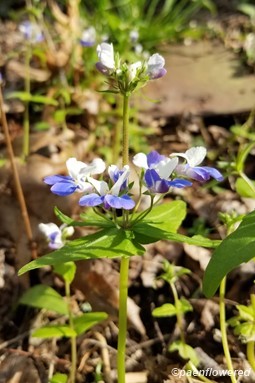Collinsia verna
Collinsia verna blue-eyed Mary
This herbaceous wildflower is a member of the plaintain family, though recently transferred there from the figwort family (Scrophulariaceae). The flowers are bi-colored with white upper lip and bright blue lower lip. The upper lip is divided into 2 lobes while the lower lip is divided into three parts. The middle lobe of the lower lip is folded lengthwise into a keel and not visible. The flowers are up to ½ inch in diameter. In some places, it is so abundant that it forms a blue carpet on the forest floor.
The plant has an unbranched, weak stem with whorls of 2-8 stalked flowers. The flowers arise from the axils of opposite, mostly stalkless leaves. The leaves are at most 2 inches long and ¾ inch wide. The lower leaves may be more oval, have a few rounded teeth and stalked.
The species is a winter annual. It drops its seeds in the summer and they germinate in the fall. The seedlings persist over the winter, allowing it to flower in the spring. The flower nectar attracts a variety of bees and sometimes dance flies and butterflies that serve as pollinators. The plant, however, can successfully self-pollinate.
The plant grows 6-24 inches tall in moist rich woodlands and on slopes. It requires a moderate amount of shade. The stem is light green and lightly pubescent. The fruit is a capsule with a few large seeds.
Blue-eyed Mary is found from western New York State, south to Arkansas, Kentucky and western Virginia. It is found as far west as southern Wisconsin. Missouri, Arkansas and eastern Iowa. It blooms from April to June depending on location. In Pennsylvania, it is restricted to the southwestern part of the state. Its northern limit seems to be Butler and Lawrence Counties. It is listed as endangered in New York State and Tennessee.
Habitat & Range
Rare, but locally abundant in floodplain forests and alluvial thickets. Prefers part shade to dappled sunlight, and moist, rich, well-drained loams.
Found in the south-western part of the state.
Range: Native to eastern and central United States, with populations extending into Ontario, Canada. In the U. S., extends from western New York State, south to Arkansas, Kentucky and western Virginia. It is found as far west as southern Wisconsin, Missouri, Arkansas and eastern Iowa.
| EMP: | FAC |
|---|---|
| NCNE: | FACU |
Phenology
Flowers from late April through May.
Seeds germinate in the fall, overwinter as seedlings, and bloom in the spring before dying back in early to mid-summer.
Characteristics
Inflorescence terminal raceme with 1 to 3 whorls of 2 to 8 flowers, from the upper nodes
Flowers strongly bilabiate, upper lip with 2 white lobes, lower lip with 2 blue lobes and one central hidden lobe with stamens and pistils; ½″ to ¾″ across; pedicels abt ¾″ long
Leaves opposite, lanceolate or ovate; up to 2″ long & ¾″ wide; lower leaves more ovate, serrate and stalked; upper leaves more lanceolate, entire, and sessile
Stem upright, usually unbranched, light green, lightly pubescent, terete
Fruit globose, glabrous capsule with 4 seeds; self-seeding
Height 12-15 inches during flowering; up to 24 inches afterwards
Plant Codes
S-rank: S4 (Apparently Secure)
G-rank: G5 (Secure)
Ecology
Main pollinators are honeybees, bumblebees, butterflies and skippers.
Provides shelter for small mammals like voles, mice, and shrews.







Comments
Have you spotted this plant in your area? We'd love to hear about your experience! Share your comments or questions about the plant below. Comments are moderated before posting.